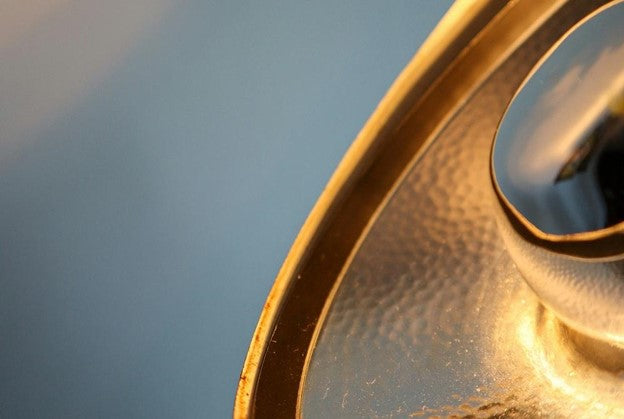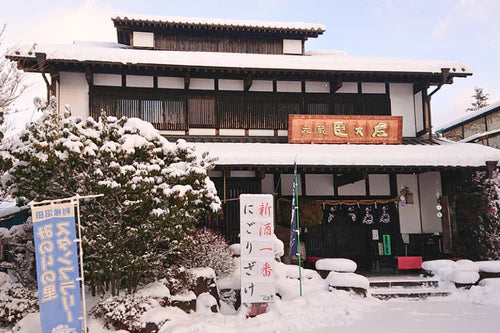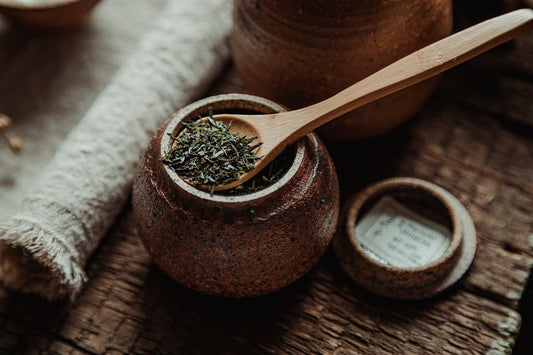It is generally said that sake tastes better when drunk on tin tableware.
Why is this so?
This article will explain why tin is suitable for sake-drinking vessels and its characteristics.
History of Tin
Tin craft techniques are said to have been introduced from China during the Asuka and Nara periods, some 1,200 to 1,300 years ago.
Two or three pieces of tin vessels, including a bottle-shaped container made of tin, are housed as treasures in the Shosoin Repository in Nara.
Typical examples of tinware have long been sake and tea utensils, such as sacred sake drinking cups and other sake vessels.
Sake and tea utensils were used as Shinto and Buddhist ritual utensils in shrines and temples, and were also widely valued by the aristocracy and warrior class.
Shuki Tin, Vessels for Enjoying Sake

Shuki tins are vessels made to hold sake.
The one that acts like a decanter is called a "tokkuri" and the cup used to drink sake directly is called a "choko/ ochoko”.
Shuki are made of various materials such as pottery, glass, wood, bamboo and metal.
There are good sake cups made of ceramics and glass, but the one introduced here is made of metal, especially tin.
Tin(Suzu), which is resistant to rust and corrosion, has been used since ancient times for Shinto and Buddhist ritual utensils and drinking vessels.
In fact, tin is subject to rust. However, it is a rust-resistant metal compared to iron and aluminum, so it rarely rusts if properly cared for.It is also said to "absorb impurities and mellow water" due to its high ionic effect.
Of course, its effect is not limited to water, but it is also said to "remove impurities and corners" and mellow sake as well, making it a popular ingredient for a long time.Tin, like gold and silver, is a highly valuable metal with absolutely no toxicity.
Furthermore, the excellent properties unique to tin transform sake into a mellow flavor.If you want to experience the effect of tin sake cups, please try them with dry sake. You will easily notice the change in flavor.
Also, because of its high thermal conductivity, tin cools down to a crisp as soon as it is placed in the refrigerator, and it warms up quickly and does not cool down easily when sake is heated Tin has no distinctive metallic smell and, unlike ceramics or glass, will not break, making it safe to use.
As time goes by, the color of tin changes, making it even more endearing.
The more you learn about tin, the more you will want to use tin drinking vessels.
Japanese Tinware
Generally, we do not try to make products with 100% tin precision because it is too soft.
There are three types of tinware: 100% pure tin, hon-tin, and pewter.
Japanese tinware is mostly made of approximately 97% pure tin, which is almost all tin and hard enough to be sharpened on a potter's wheel, and robust enough not to be deformed.
Advantages of using Shuki tin
- Because of its good heat conductivity, the heat is transferred immediately when heating sake, so there is no need for the sake to be in the heat for a long time, and the flavor is not lost.
- Due to its "excellent purifying action, tin ion action," the taste of sake is improved by eliminating the impurities.
- Since tin does not rust in water, there is no need to worry about harmful substances dissolving out of the tin, and there is no adverse effect on the human body.
- Tin does not break over time like ceramic or glass, so it can be used safely even when slightly intoxicated.
Unlike mercury and lead, tin is not toxic at all, and its properties transform sake into a mellow flavor, making it a magical metal.
It can be warmed, cooled, and enjoyed as much as one wishes on any given day.
In recent years, tinware has also been released in a variety of shapes and sizes, including beer mugs, cups, and wine cups.
Disadvantages of tinware
Frankly speaking, there are a few disadvantages, but if I had to force one, it would be that tinware is rare and expensive since most of them are individually made by hand.
A tin Tokugawa usually costs more than 10,000 yen. Therefore, it cannot be called a "familiar vessel.
Maintenance of tinware
Since tinware has a low melting point, it is best to use lukewarm water for cleaning. Tap water at room temperature will work, but lukewarm water that is about the same temperature as human skin will dissolve stains better and clean better.
You can use a general neutral detergent.
Use a soft sponge or something similar with lukewarm water and neutral detergent, and wash gently.
Tinware is not resistant to heat, so please avoid using a dishwasher or boiling water.
Using boiling water may distort the shape of the tinware.
Although it requires a little more time and effort, a tin sake cup is a perfect gift for a sake lover who can enjoy the sake of a higher grade.
Summary
Tinware is more expensive than ceramic or glassware, so it is not something you can easily afford to have. That said, once purchased, it is a material that is difficult to break, so it may become a treasured item for a lifetime.
Tinware is ideal not only for yourself, but also as a gift for your family, boss, or close friends.
I hope you will all try tinware when you have a chance.





